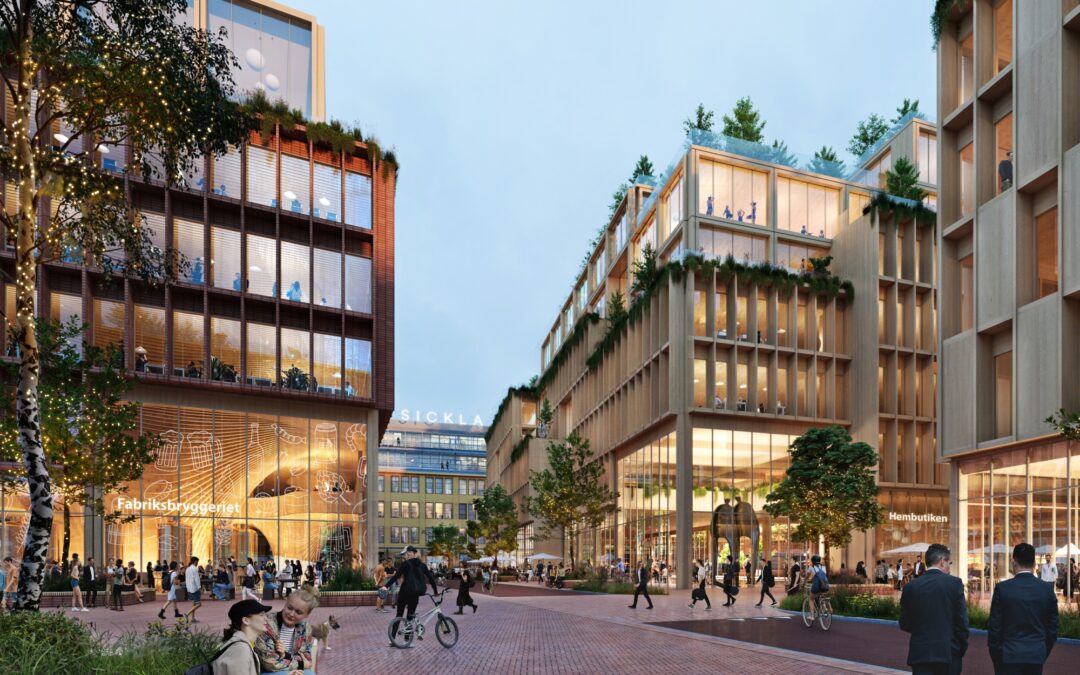Nestled in the southern outskirts of Stockholm, Sickla boasts a sprawling parking lot, equivalent to five soccer fields. But if Annica Ånäs, CEO of Atrium Ljungberg AB, has her way, this vast space is on borrowed time. She envisions a transformation from an unsightly expanse dominated by warehouses and mundane storefronts into a pioneering eco-district.
This ambitious project promises to be a world-leading, timber-engineered neighborhood encompassing 25 blocks of housing offices, residences, retail outlets, and eateries, all of which will harness renewable energy.
The Stockholm Wood City project is the latest in a worldwide uptick in timber construction. Let’s do a deep dive into Stockholm’s planned timber neighborhood and the environmental benefits of this emerging global trend in architecture and design.
A New Boom in Timber Construction
The construction industry is a top contributor to global environmental issues. Every stage in the construction process, from procuring raw materials to completing a structure, has major environmental ramifications. It places an enormous strain on dwindling natural resources, disturbs natural habitats, and contaminates water, soil, and air.
Materials central to construction, such as concrete, steel, glass, and aluminum, have emerged as critical focal points in the fight against climate change. The construction industry needs to make use of renewable materials that do not deplete natural resources and address other major climate and environmental concerns.
Among the available eco-friendly options, timber and straw stand out. Timber, a time-tested construction material, is amid a revival. This isn’t just nostalgia; it’s a strategic response to global environmental imperatives.
Mass timber construction (MTC) is at the forefront of this evolution. Beyond its green credentials, MTC aligns with modern building requirements—think taller edifices, speedy construction, and enhanced fire safety. MTC signifies a blend of age-old wisdom with contemporary innovation, pointing toward a greener construction horizon.
Mass timber is no ordinary wood. It’s engineered for resilience and has substantial potential to reduce urban carbon emissions. It acts as a carbon sink, removing carbon dioxide from the air and storing it in the timber rather than returning it to the atmosphere.
However, skeptics express concern about the fire risks of wooden buildings. MTC advocates point out that this engineered form of timber burns at a slow and predictable rate, arguably making it safer than many types of steel structures.
Sweden’s Eco-Responsibility: A Legacy of Timber
Lately, the field of architecture has experienced a significant transition toward utilizing timber-based structures. Leading countries like Norway, Switzerland, and Australia have taken the initiative to erect towering timber skyscrapers. Additionally, Singapore marked a significant achievement with the inauguration of a 468,000-square-foot college campus in May, making it the largest timber structure in Asia.
If any nation could be poised for a timber revolution, it’s Sweden. In a land where flygskam (“flight shame”), an anti-flying movement, is part of the national lexicon, it’s only natural that construction emissions have become a focus.
Furthermore, architectural enthusiasts from all over the world, including the US, the UK, and Japan, have been flocking to marvel at Sweden’s wooden wonders. From pioneering wood skyscrapers to modular apartments, Sweden’s construction narrative is embracing timber like never before.
Stockholm’s Timber Construction Revolution
Stockholm Wood City is a shining example of Sweden’s dedication to curbing emissions. The allure of the city isn’t confined to its sustainable ethos. Positioned near a new subway station, it offers a promise of connectivity, potentially attracting eco-conscious businesses.
Sweden’s timber revolution is broader than flagship projects like Stockholm Wood City. From towering wooden skyscrapers to ordinary buildings and even supermarkets, wood is steadily becoming the construction material of choice for new projects.
The country’s timber crusade is supported by evolving regulations and a diverse range of expertise spanning the entire timber ecosystem. Landowners, urban planners, and architects work together to make Sweden’s timber renaissance a collective endeavor.
Global interest in “plyscrapers”—skyscrapers made of ply or engineered wood—is on the rise, and Sweden, with its sustainable offerings, is poised to capitalize on this burgeoning demand.
Challenges to Stockholm’s Proposed Timber District
Every revolution has its challenges, and the mass timber movement is no exception. Soaring interest rates and inflation have painted a grim picture for property development, casting shadows on green projects.
Susanne Rudenstam, head of Sweden’s national agency for modern wood building, expresses concern about potential setbacks in the nation’s eco-forward construction shift. With housing prices in decline, there’s a tangible slowdown in construction endeavors.
Fluctuating lumber prices have been further intensified by geopolitical tensions, creating a rollercoaster effect. Heightened international tensions concerning Russia’s actions in Ukraine might result in a surge in lumber prices. Predictions hint at a gradual price ascent in the coming years.
Robert Boije, a renowned economist, shares a somber outlook for the immediate future of construction projects, noting they “have been hit by the rise in prices on materials.” But he is more optimistic about the timeline for Stockholm Wood City, buoyed by EU’s environmental directives and the project’s strategic proximity to public transport.

